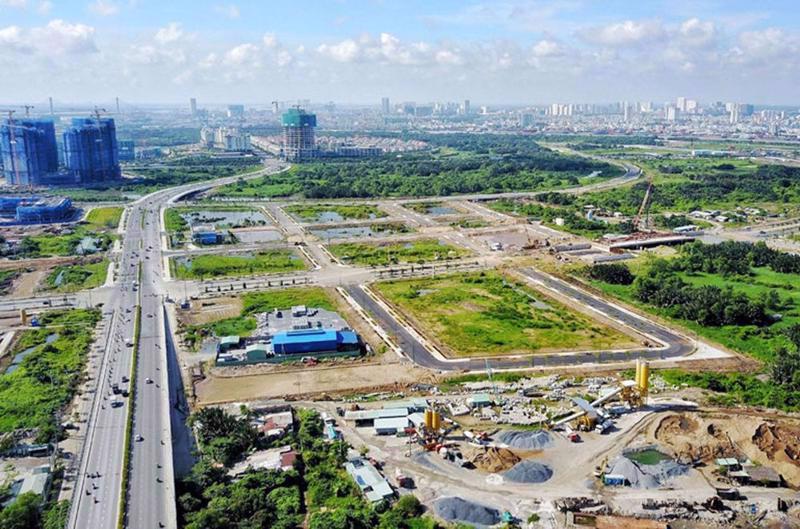Key issues in land valuation
Vietnam Economic Times / VnEconomy gathered insights from real estate insiders and experts on enhancing the land valuation system to balance interests, foster a sustainable real estate market, attract investment, and drive local socio-economic growth.

Mr. Nguyen Quoc Hiep, Chairman of GP.Invest, Chairman of the Vietnam Construction Contractors Association
With the Land Law 2024, the Law on Housing 2023, and the Law on Real Estate Business 2023 having come into effect, Vietnam’s real estate market now has a clearer legal framework. However, challenges remain, with one of the most pressing being land valuation, which is causing significant bottlenecks. For example, one of our projects received a land allocation decision nine months ago, yet the land price has still not been determined.
Decree No. 71/2024/ND-CP on land pricing was introduced as an improvement over Decree No. 12/2024/ND-CP dated February 5, 2024, which previously made land valuation difficult due to the high input costs required under the residual method. However, despite the intended improvements, Decree No. 71 still presents challenges in practice.
One key issue is infrastructure cost reimbursement. Under the law, infrastructure costs verified by local construction authorities should be reimbursed accordingly. However, in reality, this verification process is rarely conducted, and costs are instead calculated based on standard investment rates. For instance, the Ministry of Construction sets the investment rate at VND960,000 ($38.4) per sq m, but our project features high-quality infrastructure, raising actual costs to VND2.4 million ($96) per sq m. Despite this, the reimbursable cost remains fixed at VND960,000.
Another challenge in Decree No. 71 is the reliance on recent auctioned properties for land valuation. Comparing a large-scale real estate project spanning hundreds of hectares to a small auctioned plot of just a few hectares is impractical. Fully integrated projects require substantial investment, making this valuation approach unsuitable. We urge government authorities to reconsider this method and provide clearer guidelines for localities, as many currently hesitate to act due to uncertainty.
Rising land prices also pose a broader concern: Will Vietnam remain an attractive destination for investment if land costs continue to escalate? Industrial clusters around the country currently maintain an 80-90 per cent occupancy rate, largely due to three factors: affordable labor, reasonable land prices, and efficient logistics. However, if land affordability declines while labor costs rise, will our competitive edge remain? Can Vietnam continue to be a standout investment destination in Southeast Asia?
The Land Law establishes a fundamental principle: balancing the interests of the State, land users, and investors. However, the current approach to land pricing does not adequately consider business interests.
To address these concerns, we strongly recommend that the Ministry of Natural Resources and Environment issue clearer, more practical guidance on land valuation, particularly regarding the application of the residual method. A more transparent, predictable system will help create a more stable environment for investment and long-term economic growth.
Mr. Le Van Binh, Deputy Director of the Land Department, Ministry of Natural Resources and Environment
The Land Law 2024 removes the land price framework, allowing local authorities to establish their own land price tables. This change introduces a new process and decision-making structure. Under the Law, municipal and provincial People’s Committees are responsible for proposing land price tables, while People’s Councils have the authority for approving them. This reflects a more structured and professional approach to defining responsibilities between governing bodies.
Previously, a fixed land price framework dictated when adjustments could be made to either the framework or the price table. However, in practice, these adjustments were rarely implemented. Many localities wanted to make changes but were constrained by government regulations. The new law eliminates this framework, giving local authorities more flexibility in setting land prices.
For residential and resort real estate projects, land valuation will be based on specific land prices rather than the general price table. In contrast, industrial real estate projects that pay annual land rent will continue using the official price table. Other cases will follow land valuation through bidding and auction processes.
It is still too early to determine whether the Land Law 2024 will be fully successful. Evaluating legal policies takes time, often beyond a few months. The Law has only been in effect for a little over six months, and many localities are still in the process of providing staff training and implementing the new rules. Some policies may take several years to show clear results. However, early signs indicate that land prices are gradually stabilizing.
For businesses that lease land annually under the price table, higher land prices will naturally lead to increased costs. Though the law requires that cities and provinces adjust their land price tables, not all have done so. Some localities have used adjustment coefficients instead of revising the base price table annually. Under the new Law, land valuation must be calculated without adjustment coefficients, resulting in lower base prices. As a result, localities will now be required to officially update their land price tables. So far, 25 out of Vietnam’s 63 cities and provinces have adjusted their price tables, and more are expected to do so in the months to come.
Mr. Nguyen Manh Khoi, Director of the Legal Department, Ministry of Construction
The key issue currently being discussed is how to ensure the sustainable and stable development of Vietnam’s real estate market. The legal framework is already in place, with relevant laws and related decrees enacted. Before these laws were passed, extensive discussions took place, and even after their adoption, further debate has continued. The revised and newly-approved laws have been widely praised by the public.
However, after approximately six months of implementation, since August 1, 2024, certain challenges have emerged. As local authorities enforce the laws, the impact varies depending on the specific conditions in each locality. This has led to different issues arising across regions. In this context, several key points should be considered.
First, it is essential to raise awareness and clearly communicate the nature of the legal regulations. For instance, what does it truly mean to determine land prices based on market principles?
Second, we need to assess whether our land valuation consulting teams are fully equipped to meet current demands.
Third, the level of consistency in implementation across cities and provinces should be reviewed. The Law allows local authorities to adjust land price tables while waiting for the first official price table to be published on January 1, 2026. So far, over 20 localities have issued adjustments. However, if Hanoi updates its land price table while Bac Ninh province does not, for example, how will this discrepancy be managed?
Balancing the interests of the State, citizens, and investors remains one of the most challenging aspects of land valuation. Residents seeking compensation want the highest possible price, yet when buying homes they prefer lower prices. How can we create a fair and balanced approach in this situation?
From a legal management perspective, it is necessary to continue reviewing the implementation process and consider making recommendations for adjustments to the guiding decrees in the near future.
Associate Professor Dinh Trong Thinh, Economic Expert
Local authorities are currently determining land prices based more on specific areas, roads, and locations rather than considering land use purposes and actual profitability.
Ideally, the valuation of land designated for production and business activities should be based on its potential profitability for the intended use. Each type of land has a different income-generating capacity, and some serve community purposes with minimal profitability.
Setting prices for “non-agricultural production and business land that is not commercial or service land” based on road segments and locations does not fully align with market principles or established valuation methods like the income approach and residual method.
The significant increases in land price tables have already created challenges for businesses that lease land and pay annual rental fees. Since these businesses follow the regulated land price table as outlined in Article 159 of the Land Law 2024, sudden rental cost increases have made financial planning more difficult.
To address this, local authorities should be given clearer guidelines to set land prices within this category in a way that balances the interests of the State, land users, and investors. Instead of applying a single price level for all types of land in this group, pricing should reflect each plot’s actual profitability. For land with low revenue potential that mainly serves community needs, reductions or exemptions in land use and rental fees should also be considered.
Associate Professor Tran Kim Chung, Former Deputy Director of the Central Institute for Economic Management (CIEM)
The current land price framework in cities and provinces presents several key issues.
First, land prices are based on actual transactions, but real estate exchanges play a significant role in these transactions, influencing final valuations.
Second, the framework relies on auctioned land values, yet auction prices often reflect competitive bidding rather than true market conditions.
Third, valuations are determined by consulting firms, but the ultimate responsibility for land pricing lies with the municipal or provincial People’s Committee. Consultants merely provide recommendations based on legal guidelines, and their role should not be overstated.
Fourth, urbanization inevitably causes land prices to fluctuate. If updates are not made regularly, initial valuations will only serve as experimental figures with little real-world accuracy.
Fifth, the distribution of auctioned land values needs to be carefully considered. In Seoul, South Korea, the Global Real Estate Association of Seoul (GRAS) has assessed all 35 million land plots individually, allowing for accurate comparisons. A single land plot cannot serve as a reliable benchmark.
Sixth, determining land prices based on a single specific plot is problematic when there is insufficient transaction history to support a precise valuation.
Seventh, the highest land price in the framework is an important indicator.
Eighth, zoning classifications currently include “area” and “location”, but the framework also introduces a third factor: “road segment”. These criteria should be standardized.
To address these challenges, provinces and centrally-governed cities should adopt a more comprehensive, consistent, and practical approach to developing their land price frameworks. The framework should not only be valid until December 31, 2025, but should also be updated annually and published at the beginning of each year.
Additionally, land price data, from transactions, auctions, and consultancy evaluations, must be continually collected and verified for accuracy. Transparency in price declarations and transaction reporting should be strictly enforced.
Lastly, a well-structured approach to regional land price distribution is crucial for creating an accurate land price map. The practice of applying uniform pricing across different zones and subzones should be eliminated to reflect true market conditions.
Ms. Vu Lan Anh, Deputy General Director of the CEO Group
Local authorities currently impose very high one-time land lease fees for commercial service land used in tourism and resort projects. These high land costs drive up real estate prices, making it less attractive for investors to develop tourism and resort projects on such land. To ensure a balanced approach, localities should adopt a scientific pricing method based on market-driven principles and harmonized benefits. Ideally, commercial service land prices should be set at 20 to 40 per cent of residential land prices.
For infrastructure areas within resort tourism projects, such as internal roads, landscaped green spaces, wastewater treatment stations, and public squares, land lease fees should be waived for the entire duration of the project. Only the business-use land areas should be subject to lease fees. Additionally, investors should have the option of transferring the infrastructure back to the State, similar to urban development projects.
Regarding the residual method for determining commercial service land prices, the current approach relies heavily on auction-winning land prices, often based on small land plots. This is problematic, because applying prices from small plots to large-scale projects does not reflect true market conditions.
Other cost factors are also underestimated. Sales expenses are currently capped at 1 per cent of revenue, while the actual figure typically ranges from 10 to 15 per cent. Loan interest expenses are only considered for 50 per cent of total borrowed capital and limited to one to two years, which does not reflect the real financing structure of large-scale projects.
As a result, land valuation currently assumes the highest possible revenue while significantly underestimating costs. This forces businesses to pay excessive land use fees, driving up real estate prices, fueling market bubbles, and distorting fair land pricing.
To address these issues, we propose revising the regulations on the residual method for land valuation. Revenue should not be based on auction-winning prices or small land plot samples. Instead, it should reflect broader market trends over an extended period. Additionally, cost calculations must be more precise and fully account for actual project expenses to ensure fair and sustainable pricing.
Ms. Giang Do, Director of Advisory, Savills Vietnam
The updated land price framework, which is now more in line with market values, makes compensation more transparent and fair, helping to reduce land disputes. This not only builds public trust but also speeds up land clearance, which is a key factor for large-scale projects.
A more transparent pricing system based on real market conditions will also increase confidence among foreign investors. With clearer valuation standards, they can better estimate costs and calculate potential returns.
However, the new land price framework creates financial pressure for developers. Higher land use costs drive up real estate prices, making housing less affordable. There is growing concern that these rising costs will significantly impact home prices, particularly in the mid-range and affordable segments. This challenge needs careful attention. In suburban areas, the new pricing system also makes it harder to convert agricultural land into residential use, limiting opportunities for affordable housing projects.
To address these issues, it is essential to apply modern technology and improve transparency in land valuation. Automated valuation models and geographic information systems have proven effective in making land pricing more accurate and reflective of actual market conditions. These tools also help minimize subjective influence, increasing trust among both the public and businesses.
Another important solution is to develop an online land price information portal. A transparent and publicly accessible system showing land prices by area would allow citizens, businesses, and investors to easily find relevant information, helping them make better decisions. Improving transparency not only strengthens trust but also supports more effective land management.
At the same time, the pricing system should be adjusted to avoid applying the same land price across an entire road, even when different sections have varying characteristics such as traffic flows, infrastructure connections, and accessibility. More detailed categorization would ensure fairness between different locations and make the pricing framework more practical.
By combining modern technology with a more refined approach to land valuation, the system can become more transparent, supporting a balanced and sustainable real estate market that benefits all stakeholders.







![[Interactive]: Economic overview - April 2025](https://media.vneconomy.vn/400x225/images/upload/2025/05/06/5a245778-67b1-4874-a8dc-21f8cfed62a6.png)